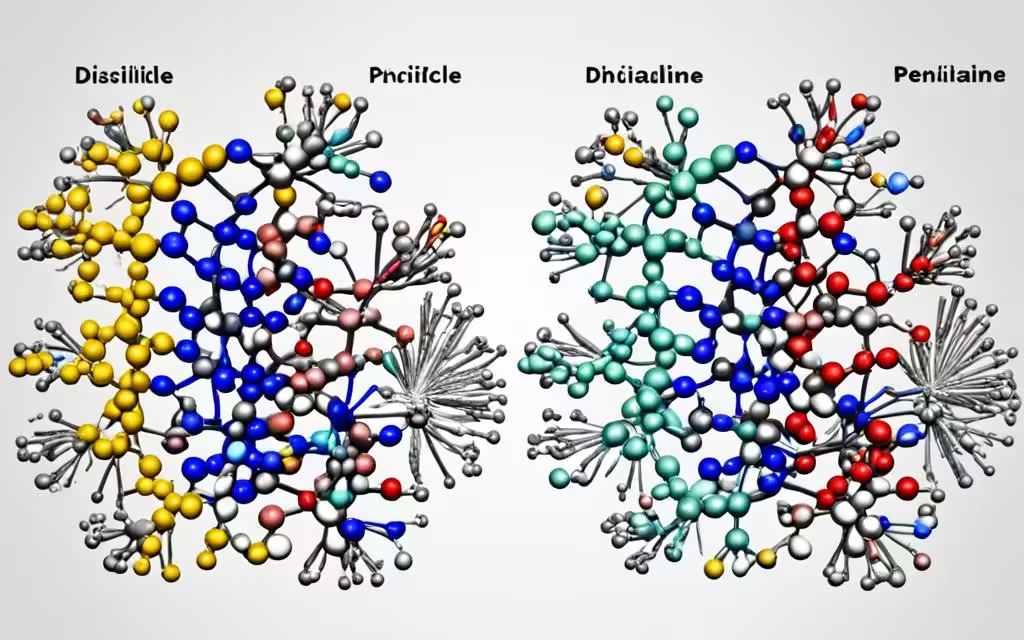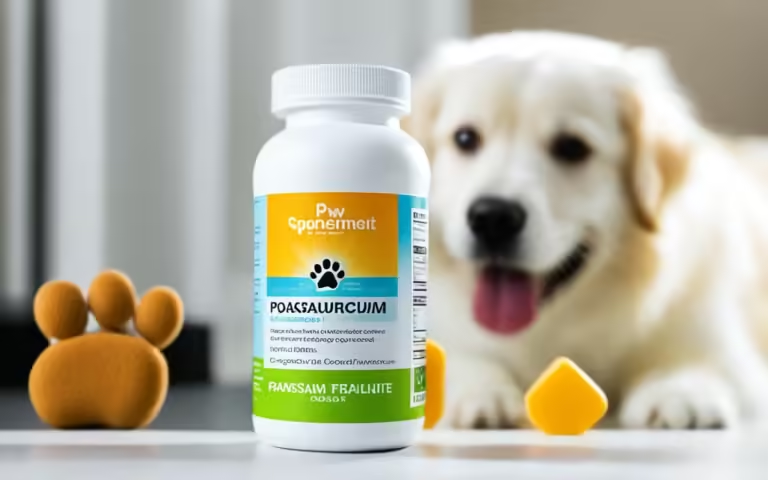Penicillamine for Dogs: Uses and Safety Guide
Penicillamine is a key medicine for dogs, given by vets. It helps treat1 copper storage hepatopathy, a condition where too much copper builds up in the liver. This can harm the liver and cause scarring. It often comes from genetic issues or other liver problems1.
Penicillamine works by removing extra copper from the liver. It can also help get rid of too much lead or mercury in cases of poisoning1.
Even though it’s approved for humans, penicillamine isn’t yet approved for dogs by the FDA1. But vets can legally use human drugs for pets, known as extra-label use. This lets them use penicillamine for dogs.
Key Takeaways
- Penicillamine is often used off-label in vet medicine for treating copper storage hepatopathy and metal poisoning in dogs1.
- Don’t use penicillamine on pets with kidney issues, lead in their gut, or if they’re allergic to penicillin1.
- It can lower essential vitamins and minerals in pets, and taking too much can be harmful1.
- It might take weeks or even months to work on dogs1.
- Keeping penicillamine at the right temperature is key to its effectiveness1.
Table of Contents
What is Penicillamine?
Definition and Background
Penicillamine is a type of medicine that helps remove certain metals from the body1. It comes from penicillin but doesn’t work like an antibiotic. Vets use it to treat many health issues in animals, like liver problems, poisoning, and certain stones1.
Uses in Veterinary Medicine
Vets use penicillamine to help animals with liver issues from too much copper, or if they are poisoned by lead or mercury1. It also helps with kidney and bladder stones caused by a problem with an amino acid1. Even though the FDA doesn’t approve it for pets, vets can still use it if they think it’s right1.
“Penicillamine is used off-label in veterinary medicine to treat copper storage hepatopathy and metal (lead and mercury) toxicity in dogs.”1
Humans can get penicillamine under the names Cuprimine® or generic, but it’s not for pets1. Vets can make special medicines, like penicillamine, just for a pet’s needs1.
Penicillamine can make pets lack important vitamins and minerals like zinc and iron1. It might take a while, even months, to work in dogs1.
There aren’t studies on how bad penicillamine can be for animals, so talk to a vet if you think your pet took too much1. Keep it in a cool, dry place away from light1. If your pet has bad side effects or you’re worried, call a vet1.
Penicillamine for Copper Storage Hepatopathy
Copper storage hepatopathy is a condition where too much copper builds up in a dog’s liver. This can cause serious liver damage and scarring2. It often happens because of a genetic issue, but other liver problems can make it worse2. If not treated, it can lead to severe illness and even be life-threatening for dogs.
Understanding Copper Storage Disorders in Dogs
Normal levels of copper in a dog’s liver are between 120 to 400 mg per kilogram of dry weight2. But levels above 600 mg/kg DW are dangerous2. Some breeds, like Bedlington terriers, are more likely to get copper storage disorders because of a genetic issue2. A study on Labrador retrievers found certain gene mutations linked to high copper levels in the liver2. Also, the rise in copper-related liver problems in dogs is partly due to too much copper in some dog foods2.
Effectiveness of Penicillamine Treatment
Penicillamine is a key treatment for dogs with copper storage hepatopathy3. It works by binding to the extra copper in the liver, making it easier to remove through the kidneys2. Research shows it can greatly improve liver health and lower copper levels in affected dogs3. Starting treatment early is very important for a better outcome3.

Along with penicillamine, putting dogs on a low-copper diet is crucial3. Adding zinc might also help by stopping copper from being absorbed3. With the right treatment and diet, dogs with copper storage hepatopathy can live better lives.
Penicillamine for Lead and Mercury Poisoning
Penicillamine is not just for copper issues; it can also help dogs with lead and mercury poisoning4. It binds to these heavy metals, helping to remove them from the dog’s body4. Vets might use it as a second choice to treat these poisonings, but other chelating agents might work better.
Research shows penicillamine is good at removing lead in humans and animals4. Studies by Goldberg et al. (1963) and Ohlsson (1962) prove its effectiveness against lead poisoning4. It’s also been tested against arsenic and mercury poisoning, as seen in Peterson and Rumack (1977) and Troger et al. (2001)4.
Using penicillamine for heavy metal poisoning in dogs has its risks and side effects5. Dogs might get sick, feel depressed, or have stomach problems. It’s not good for dogs allergic to penicillin or those with blood issues from penicillamine5. It can also lower the absorption of important minerals like zinc and iron5.
Deciding to use penicillamine for poisoning should be with a vet’s advice6. They’ll look at the situation, risks, and other treatment options6. Penicillamine is quickly absorbed and cleared from the body, which is important to know6.
In summary, penicillamine can help dogs with lead and mercury poisoning, but it’s important to think about the pros and cons carefully. Vets will look at each case and consider other treatments and risks of penicillamine.
Mechanism of Action: How Penicillamine Works
Penicillamine is a key drug in veterinary medicine, acting as a chelating agent7. It binds to metals like copper, lead, and mercury in the body. This binding helps remove these metals by making them easier to get rid of through the kidneys7.
Chelation Therapy
Penicillamine’s main way to treat metal problems in dogs is through chelation therapy7. It attaches to extra metals, making them easier to remove from the blood and pass out in urine7. This is vital for treating issues like copper storage in the liver and poisoning from lead or mercury7.
Removing Excess Metals from the Body
Penicillamine helps get rid of metal-penicillamine complexes, lowering harmful metal levels in the body7. It’s especially useful for conditions like Wilson’s disease and cystinuria, preventing kidney stones7. It can also help with other metals like arsenic, mercury, and lead, but some chelators work better and are safer4.
In short, penicillamine’s action as a chelating agent makes it a key treatment for metal disorders in animals7. It removes extra metals, easing symptoms and complications7.

Penicillamine Dosage and Administration
Dosage Guidelines for Dogs
For dogs, the right amount of penicillamine is 5 to 7 milligrams (mg) per pound (15 mg/kg) given twice a day8. This is often used for treating copper-related issues like copper storage hepatopathy. If your dog has lead poisoning, the dose might be 15 to 50 mg per pound (30 to 110 mg/kg) split into three to four doses9. Your vet will decide the best dosage and how long your pet needs it based on their health and how they react to the medicine.
Proper Administration Techniques
Give penicillamine on an empty stomach, at least 30 minutes before eating8. Food can lower how much of the medicine your pet absorbs. If your pet eats less, feels sick, or vomits, your vet might suggest an anti-nausea medicine or a lower dose. Then, they can slowly increase it as your pet gets better.
Always follow your vet’s advice when giving penicillamine to your dog. Getting the dosage and timing right is key for the medicine to work well and to avoid side effects8109.
“Accurate dosing and timing of penicillamine administration are critical for the successful treatment of copper storage disorders and other metal toxicities in canine patients.”
| Medical Condition | Typical Penicillamine Dosage |
|---|---|
| Wilson’s Disease | Adults and teenagers: 250 mg four times a day, up to 2000 mg a day Children (older than 6 months): 250 mg a day, with possible increases based on urine tests |
| Rheumatoid Arthritis | Adults: 125 or 250 mg once a day, up to 1500 mg a day Children: Dosage determined by a doctor |
| Kidney Stone Prevention | Adults: 500 mg four times a day, up to 4000 mg a day based on urine tests Children: 7.5 mg per kilogram of body weight four times a day |
Your vet will decide the right dosage and schedule for your dog based on their specific needs and health8109.
Penicillamine for Dogs
Penicillamine is a versatile drug used in veterinary medicine for dogs. It treats health issues like copper storage problems and metal poisoning1. Even though the FDA doesn’t approve it for animals, vets can use it if they think it’s best for a pet’s health1.
This drug works by removing harmful metals from the body. It’s useful when other FDA-approved drugs won’t work, like if a pet can’t swallow pills or needs a certain strength1.
But, penicillamine can have side effects in dogs. These include stomach problems, fever, swollen lymph nodes, skin rashes, and kidney issues1. Keeping it in a cool, dry place is important to keep it safe1.
There aren’t many studies on how safe penicillamine is for animals1. Giving too much can be harmful, and getting advice from a vet is important if you think your pet has taken too much1.
Penicillamine is often used to treat dogs with liver problems caused by too much copper1112. But, it can also cause kidney and skin problems. Regular blood tests are needed to check how the dog is doing on the treatment11.
Penicillamine is a valuable drug in veterinary care. It helps with many health issues in dogs, like copper problems and metal poisoning. But, vets must watch for side effects and use it carefully11112.
Potential Side Effects and Precautions
Penicillamine is usually safe and works well when a vet prescribes it. But, some dogs may have side effects13. Common side effects include nausea, vomiting, and not wanting to eat13. Rarely, dogs might get a fever, kidney problems, skin reactions, or blood issues13.
Common Side Effects
Some dogs may get a skin rash, fever, sore throat, chills, bruising, bleeding, trouble breathing, and cough from penicillamine13. Older dogs might get a skin rash more easily13. There’s no special info on kids, but it likely won’t affect them differently than adults13.
Precautions and Contraindications
Don’t use penicillamine on animals allergic to it13. It can also interact with other medicines like Aurothioglucose, Auranofin, Gold Sodium Thiomalate, and Magnesium Sulfate13. Tell the vet about any other meds your pet is on13. Also, be careful with pregnant or nursing animals because it can cause birth defects13.
If your pet has had blood or kidney problems before, they might react worse to penicillamine13. Pets taking it for different health issues need to follow specific instructions, like taking it on an empty stomach and sticking to certain diets13.
| Factors to Consider When Prescribing Penicillamine | Precautions and Contraindications |
|---|---|
| Medication interactions (e.g., Aurothioglucose, Auranofin, Gold Sodium Thiomalate, Magnesium Sulfate) History of blood or kidney disease Pregnancy and nursing Dietary requirements (e.g., taking on an empty stomach) | Hypersensitivity or allergy to penicillamine Increased risk of side effects in elderly patients and those with a history of penicillamine-related blood or kidney issues Potential for birth defects in pregnant animals |
When thinking about Penicillamine Precautions for Dogs and possible Adverse Reactions to Penicillamine, it’s key to consider these when giving this medicine to Canine Medication Side Effects13. Always talk to a vet and watch your dog closely while they’re taking penicillamine13.
“Penicillamine is a strong medicine that can help with some conditions. But, knowing the possible Penicillamine Side Effects in Dogs and being careful is important.”
Monitoring During Penicillamine Treatment
Your dog’s health will be closely watched during penicillamine therapy. This includes regular blood and urine tests. These tests are key to check how well the treatment is working and to keep your dog safe.
Blood and Urine Tests
Your vet will do blood and urine tests to check the penicillamine levels in your dog. They will also look at how the medicine affects the liver, kidneys, and overall health14. These tests help figure out the right dose and how long to give the medicine.
Blood tests might check liver enzymes like ALT and ALP to see how the liver is doing15. Urine tests show how well your dog is getting rid of copper and other metals, which tells if the treatment is working.
Assessing Treatment Efficacy
By watching how your dog reacts to the penicillamine, your vet can see if it’s working14. They look for better liver function, less copper or other metals, and signs of overall improvement.
The treatment might change based on how your dog responds and what the vet thinks14. Sometimes, dogs need to take penicillamine for a long time to keep their liver safe from copper buildup16.
| Test | Reference Range | Findings During Penicillamine Therapy |
|---|---|---|
| Alanine Transaminase (ALT) | 10 to 125 U/L | Increased levels (e.g., 1640 U/L) due to liver damage, which decreased after discontinuing penicillamine15 |
| Alkaline Phosphatase (ALP) | 23 to 212 U/L | Increased levels (e.g., 557 U/L) due to liver disease, which improved after stopping penicillamine15 |
| Neutrophil Count | 2950 to 11,640/μL | Decreased levels (e.g., 800/μL) indicating neutropenia, which improved after discontinuing penicillamine15 |
| Hepatic Copper Concentration | Varies by breed | Significant reductions in copper levels in dogs treated with penicillamine compared to untreated controls14 |
Keeping a close eye on your dog’s response to penicillamine is key for safe and effective treatment. By tracking changes in blood and urine tests, your vet can make the best treatment plan for your dog.
Comparison with Other Chelating Agents
Penicillamine is often used to treat dogs with copper storage disorders and metal toxicities. But, it’s not the only choice. Vets pick the best treatment based on the pet’s condition, symptoms, and treatment cost17.
Efficacy and Cost Considerations
Penicillamine works well to remove metals from the body. Yet, it might not always be the best or cheapest option. Other drugs like dimercaptosuccinic acid (DMSA) or zinc-EDTA could be better for some dogs6. The right choice depends on the metal type, the dog’s health, and the drug’s side effects and price17.
Choosing the Right Treatment Option
Vets look at each dog’s needs to pick the right chelating agent. They consider how well the drug works, its side effects, and its cost17. Studies show penicillamine can treat copper disorders and metal poisoning in dogs12. But sometimes, other drugs might work better for your pet17.
Your vet will work with you to find the best treatment for your dog’s needs17.
| Chelating Agent | Efficacy | Cost | Potential Side Effects |
|---|---|---|---|
| Penicillamine | Moderate to High | Moderate | Mucocutaneous reactions, proteinuria, bone marrow suppression |
| DMSA | High | High | Gastrointestinal upset, rash, headache |
| Zinc-EDTA | Moderate to High | Moderate | Nausea, vomiting, hypocalcemia |
This table shows how different chelating agents compare in effectiveness, cost, and side effects. Penicillamine is a common choice, but other options might be better for your pet6.
“The choice of chelating agent will depend on the specific condition, the severity of the pet’s symptoms, and the potential benefits and drawbacks of each treatment approach.”
Choosing the right chelating agent for your dog involves many factors. Your vet will help pick the safest and most effective treatment for your pet’s condition17.
Drug Interactions and Contraindications
When giving penicillamine to dogs, knowing about possible drug interactions and contraindications is key18. It can mix with some medicines like antacids, azathioprine, and cyclophosphamide19. Even though serious drug interactions are rare in vet medicine, they might be more common than we think because of more drugs being used in pets19. Always tell your vet about all the meds, supplements, and vitamins your pet is on, as they could affect how well or safely penicillamine works.
Don’t use penicillamine if your pet is allergic to it18. Be careful if your pet is pregnant or nursing, as it might cause birth defects18. Giving pets too many drugs at once can also lead to more interactions19.
| Medication or Condition | Interaction or Contraindication |
|---|---|
| Digoxin, Gold Salts, Malaria Medications, Other Drugs That Decrease Bone Marrow Function | Drug Interactions with Penicillamine18 |
| Pregnant or Nursing Dogs | Caution Advised with Penicillamine Use18 |
| Hypersensitivity or Allergy to Penicillamine | Contraindication for Penicillamine Use18 |
| Multiple Medications (Polypharmacy) | Increased Risk of Drug Interactions19 |
Keep a detailed list of all your pet’s meds, including over-the-counter and herbal products, to avoid bad reactions with penicillamine18. Mixing drugs can change how they work, making them more toxic or affecting how they move through the body19.
In summary20, there are 108 known drug interactions with penicillamine, and 5 disease interactions20. It also has 2 alcohol/food interactions, with 27 major and 81 moderate interactions20. When giving penicillamine to dogs, think carefully about these to keep them safe and healthy.
Conclusion
Penicillamine is a key medicine in vet care for treating Summary of Penicillamine for Dogs, lead poisoning, and more in dogs21. It works as a chelating agent, grabbing onto and removing extra metals from the body. This helps lessen harm to the liver and other organs21.
Vets can legally use penicillamine even though it’s not FDA-approved for pets. They do this when they think it’s the best treatment for a pet’s issue. Key Points about Penicillamine Use in Canines It’s crucial to have a vet watch over the treatment to make sure it’s safe and works well21.
Importance of Veterinary Supervision for Penicillamine Treatment Penicillamine might cause side effects like stomach problems, blood issues, and reactions with other drugs21. Regular blood and urine checks are needed to see if the treatment is working and to watch for bad effects. With the right vet advice and care, penicillamine can help manage many health issues in dogs22.
FAQ
What is penicillamine and how is it used in veterinary medicine?
How does penicillamine work to treat copper storage disorders in dogs?
Can penicillamine be used to treat lead and mercury poisoning in dogs?
What is the typical dosage of penicillamine for dogs?
What are the potential side effects of penicillamine in dogs?
How is the effectiveness of penicillamine treatment monitored in dogs?
Are there any interactions or contraindications with penicillamine in dogs?
Source Links
- Penicillamine for Dogs
- Copper Hepatopathy in Dogs
- Copper Storage Disease in Dogs
- D-Penicillamine
- Penicillamine Quad Tab | Integrative Veterinary Care
- Penicillamine – an overview | ScienceDirect Topics
- Penicillamine: MedlinePlus Drug Information
- Chronic Hepatitis in Dogs – Diagnosis and Treatment – WSAVA2011
- Penicillamine (Oral Route)
- Cuprimine, Depen
- D-penicillamine-associated neutropenia in a Doberman pinscher – PubMed
- D-Penicillamine: The State of the Art in Humans and in Dogs from a Pharmacological and Regulatory Perspective
- Penicillamine (Oral Route) Side Effects
- Penicillamine – an overview | ScienceDirect Topics
- D-penicillamine-associated neutropenia in a Doberman pinscher
- Diagnosing and treating canine copper-associated hepatopathies
- Wilson Disease Medication: Chelators, Nutrients
- Penicillamine Oral: Uses, Side Effects, Interactions, Pictures, Warnings & Dosing – WebMD
- Drug-drug interactions (Proceedings)
- Penicillamine Interactions Checker – Drugs.com
- Penicillamine – an overview | ScienceDirect Topics
- What to do if you suspect liver disease







